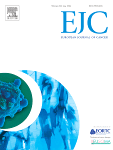
Publication date: November 2017
Source:European Journal of Cancer, Volume 86
Author(s): Andrea Casadei Gardini, Luca Faloppi, Serena De Matteis, Francesco Giuseppe Foschi, Nicola Silvestris, Francesco Tovoli, Vincenzo Palmieri, Giorgia Marisi, Oronzo Brunetti, Umberto Vespasiani-Gentilucci, Giuseppe Perrone, Martina Valgiusti, Anna Maria Granato, Giorgio Ercolani, Giulia Negrini, Emiliano Tamburini, Giuseppe Aprile, Alessandro Passardi, Daniele Santini, Stefano Cascinu, Giovanni Luca Frassineti, Mario Scartozzi
PurposeIn 2015, we published a study on a small series of patients with hepatocellular carcinoma (HCC) treated chronically with metformin for type II diabetes mellitus (DM2) who showed a poorer response to sorafenib. The aim of the present study was to validate the prognostic significance of metformin in HCC patients treated with sorafenib, providing a biological rationale for the mechanism of resistance to sorafenib in patients on chronic metformin therapy, and to clarify the role of sirtuin-3 (SIRT-3), a protein involved in metabolic diseases and acknowledged as a tumour suppressor in HCC, in this resistance.Patients and methodsWe analysed 279 patients consecutively treated with sorafenib for the clinical analysis. Of the 86 (30%) patients with DM2, 52 (19%) were on chronic treatment with metformin and 34 (12%) with insulin. We included 43 patients with HCC for the biological study: 19 (44.1%) were diabetic and 14 (73.7%) of these received metformin for DM2. SIRT-3 expression was investigated by immunohistochemistry (IHC) in formalin-fixed and paraffin-embedded (FFPE) samples.ResultsIn HCC patients undergoing chronic treatment with metformin, the use of sorafenib was associated with poor progression-free survival (PFS) and overall survival (OS) (1.9 and 6.6 months, respectively) compared to 3.7 months and 10.8 months, respectively, for patients without DM2 and 8.4 months and 16.6 months, respectively, for patients on insulin (P < .0001). We also observed that SIRT-3 protein expression was significantly higher in patients treated with metformin than in those not taking this medication (65% versus 25%, respectively) (P = .013).ConclusionsOur findings could be attributed to increased tumour aggressiveness and resistance to sorafenib caused by chronic treatment with metformin.
from Cancer via ola Kala on Inoreader http://ift.tt/2xT9qnC
via
IFTTT
